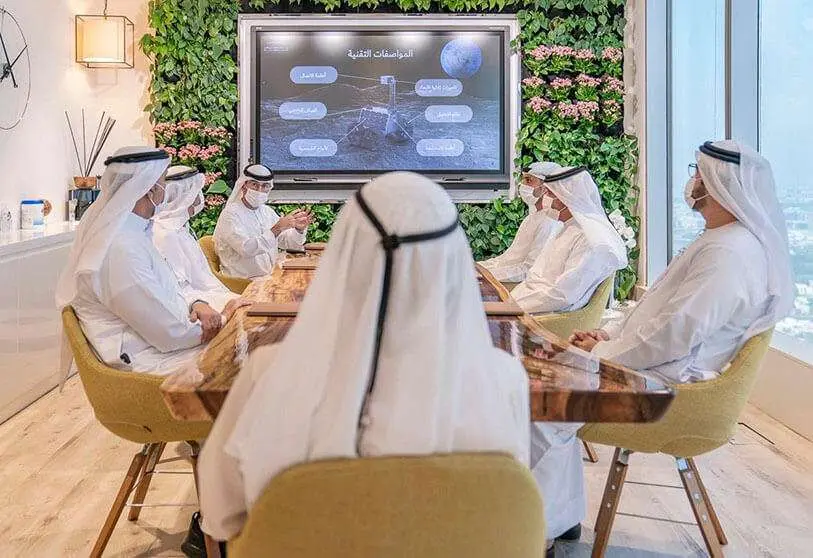Emirates surprises the world again with a mission to the moon

The Emirates has once again stunned the international community with its recent official announcement that it intends to have an all-terrain exploration vehicle on the moon by 2024.
On the first anniversary of the flight into space of the Emirati astronaut Hazza al-Mansouri and with the scientific probe Al-Amal still en route to Mars-where it will arrive in February 2021-the vice president and prime minister of the Emirates and top leader of Dubai, Sheikh Mohammed bin Rashid al-Maktoum, has just launched its Space Agency's project to make the Gulf country the first Arab nation and the fourth worldwide to descend on our natural satellite, after the United States, Russia (as heir to the Soviet Union) and China.
Called the Emirates Lunar Mission, the initiative is part of the recently approved 2021-2031 space strategy defined by the Mohammed bin Rashid Space Centre (MBRSC), the roadmap that brings together the projects that the country is going to activate during the aforementioned decade and for which there is already a $6 billion budget.

Considered by the emirate authorities to be "the biggest national project" and also "the biggest in the region", the rover explorer has been named "Rashid", after the moderniser of the emirate of Dubai who governed it for 32 years (from 1958 to 1990) and was also one of the promoters of the creation of the Union of Arab Emirates in 1971.
It is planned that the place where the vehicle will descend and its exploratory activity will take place on the visible face of the moon, but in an unexplored area, so that it can provide new images and data of great value to the international scientific community.

"Rashid" will be designed and manufactured in the Emirates by a team composed entirely of engineers, technicians and researchers from the country. Built on a light but robust structure to protect devices and equipment from temperature changes, it will have four driving wheels to move at a speed of 10 centimetres per second and will be powered by solar panels.
In total, it will weigh only 10 kilos and will have a mast on which two tiny high-resolution cameras will be fixed, another 3D camera, one more for capturing microscopic images and a fifth with thermal sensitivity for taking night-time images, all of which will have a great capacity for movement. The on-board computer will send around a thousand images to the MBSRC control room in Dubai, including the sequence of the critical phase of descent on the Moon.
Although it will be very small, measuring just 53.85x53.5x8.49 centimetres - about the size of a laptop computer - the scientific objectives of the mission include studying the components of the moon's surface, its dust particles and existing radioactivity, as well as measuring and testing the new materials to be brought on board.

It will also include a communications system to link up with the Earth, send data and receive instructions for moving around the area to be explored, for which it will have a state-of-the-art navigator and sensors to analyse soil properties.
The multidisciplinary team from the United Arab Emirates at the MBRSC is already working on "Rashid" at cruising speed. They want to have the project and the basic design of the small exploration vehicle completed by 2021. The plans outlined by the MBRSC's general manager, Yusuf Hamad al-Shaibani, are to start production in 2022, to have the first sensor models and preliminary experiments in 2023 and to carry out tests with the first prototype in the same year.

The launch of the small vehicle is set for 2024, but this will only be possible if the timetable for action is not delayed. The launcher has not yet been hired, although the priority candidates are the Japanese H-IIA, which put the Martian Al Amal probe into orbit last July, and the KhalifaSat satellite in October 2018, and also the Russian Soyuz-2, which sent the nanosatellite MeznSat, weighing only 3 kilos, into space a few days ago.
There are still some major gaps in the plans outlined by the Emirates. The most important of these is the ship in which "Rashid" will travel from the Earth to the moon, about which nothing is known. Other gaps to be defined are the lifetime of the rover on the lunar surface, as well as the company or space agency that will collaborate with the MBRSC to ensure the correct descent on the lunar surface of the module that will protect "Rashid" from the impact against the lunar surface.
India and Israel failed miserably in trying to land on our natural satellite. On 6 September 2019, the Indian ship Chandrayaan 2 ejected the Vikram lander, which housed the 27-kilogram, six-wheeled Pragyan vehicle, but crashed into the lunar soil. Israel tried something similar with the 585-kilogram Beresheet probe, which also crashed and was destroyed on 11 April 2019.
From the MBRSC director general's perspective, the data obtained by the Emirates' lunar mission will create a knowledge base that will serve to "help build a research station on the moon" and to develop equipment "that can be used in future space exploration missions".

The Moon is considered a good scenario for testing new technologies. According to Sheikh Mohammed bin Rashid al-Maktoum, his country has an ambitious space programme which, combined with an unwavering will, strategic governance and a large number of scientists, researchers and engineers, may lead to the Emirates deciding to "participate in manned missions to Mars".
According to Yusuf Hamad al-Shaibani, the fact that his nation is part of the group of nations with a marked interest in space confirms that "the Arab world, with will and determination, is beginning to make significant changes and achievements".










